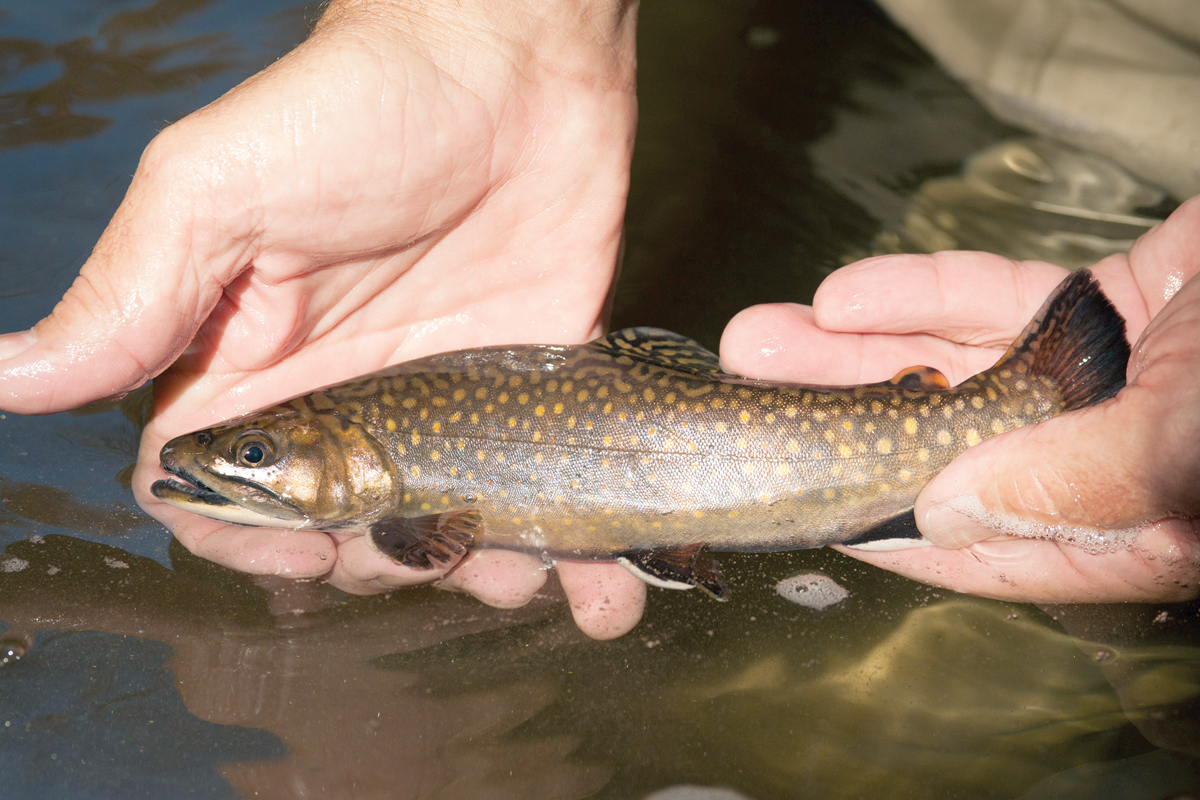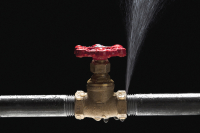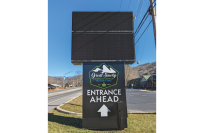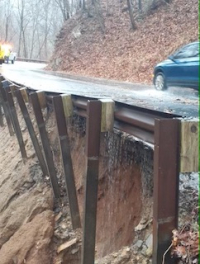Billion-dollar catch: Report reveals economic impact of N.C. trout fishing industry
 Because trout require clean, cold water, trout fishing goes hand-in-hand with environmental conservation. NCWRC photo
Because trout require clean, cold water, trout fishing goes hand-in-hand with environmental conservation. NCWRC photo
The economic impact of trout fishing in North Carolina has more than tripled since 2014, clocking in at $1.38 billion in 2022 according to a report just released by the N.C. Wildlife Resources Commission.
It’s a big number that’s caught even those who work in the industry by surprise.
“Anything outdoors dealing with the pandemic just exploded, but it’s all kind of relative, so I wouldn’t have thought it would have been an exponential increase like that,” said Dale Collins, co-owner of Tuckasegee Fly Shop.
The report shows that trout fishing represents a significant chunk of the $14.6 billion value-added impact that a different study , published by the U.S. Bureau of Economic Analysis, estimated for the state’s overall outdoor recreation economy in 2022. For every dollar spent on trout fishing in North Carolina, the Wildlife Commission study found, there was a $1.93 return to the state’s economy.
Triple the impact
The 360% surge in impact since the last report published in 2015 far outstrips the 29% cost-of-living increase that occurred over that timeframe and has been pushed along by a significant rise in fishing license sales. The number of people holding freshwater fishing licenses in North Carolina increased by 53% between 2014 and 2023, clocking in at 1.2 million this year. Compounding the effect, trout fishing became an increasingly popular way to enjoy North Carolina’s freshwater streams. The percentage of freshwater fishing license holders who fished for trout grew from an estimated 18.5% in 2015 to 32% in 2022.
Related Items
The report did offer one caveat to this picture of growth. While half of respondents said their level of trout fishing activity had not changed in the past five years, 30% said it had decreased — a much larger proportion than the 18% who said it had increased.

Data from a new N.C. Wildlife Resources Commission report shows the economic impact of trout fishing. NCWRC table
“This jump may be explained by the increase in recreational fishing due to the COVID-19 pandemic within the last five years,” the report states, “As the world shifts back to pre-pandemic activities, it is possible anglers are returning to their pre-2020 fishing activity, which may explain the anglers reporting their trout fishing decreasing.”
The report is based on the results of a survey emailed to a simple random sample of more than 25,000 people who had an active fishing license in 2022. Of those respondents, 510 said they fished for trout, and their responses formed the basis for this report.
More of these anglers are coming from inside the state than was in the case a decade ago. The 2015 study found that 82% of North Carolina trout anglers were residents and 18% were non-residents, while this year’s study found that 87% were residents and 13% nonresidents. This shift in proportion may also contribute to the overall increase in economic impact, because equipment expenditures for nonresidents are not reported as having any economic impact in the state of North Carolina. With a larger proportion of in-state anglers comes a larger proportion of in-state expenditures.
Covering 26 counties, the region involved in trout fishing is large, and the study did not break down economic impact estimates by any more specific geographic area. However, there’s reason to believe the far western counties are getting a significant proportion of the benefit.
One series of questions in the survey asked anglers to name their first, second and third most-fished counties. While Ashe, Avery and Watauga counties — all of which are closer to the Charlotte metro area than counties in the far western region — took prominent spots in all three questions, Jackson, Haywood, Transylvania, Cherokee and Swain counties also proved to be favorite fishing spots.
Jackson County tied with Avery County for third place most-fished county, while Haywood was fifth and Transylvania eighth. Transylvania County was the second most common answer when anglers were asked for their second most-fished county, while Cherokee County was fifth and Haywood tied for sixth. When anglers were asked for their third most-fished county. Swain was third, Cherokee was fifth and Transylvania tied for sixth.
“We do know that 72% of all the spending that happens in relation to trout fishing happens in the county where people are fishing,” said Cristina Watkins, lead social scientist for the Wildlife Commission. “We found that in the survey, so there is a good amount of the economic impact that is happening very local to where people are actually fishing.”
The survey found that local anglers averaged $112 per trip, while non-local anglers spent $276 per trip, a difference largely due to lodging and fuel costs.
Campers, RVs, ATVs and trucks led the way in accounting for trout fishing’s overall economic impact, responsible for $406.3 million of the total, followed by lodging at $158 million. Other big categories were vehicle and boat fuel at $84 million, motorized boats at $79.3 million, restaurants at $75.7 million and groceries, camping supplies and rods and reels at $44.5 million, $44.2 million and $41.1 million, respectively.
Collins posited that overall growth in North Carolina’s tourism industry since 2015 has contributed to the impact of trout fishing.
“We’ve got a better service industry in Western North Carolina now than I think we did in 2015, so there’s more restaurants to choose form, there’s more breweries to choose from, there’s more choices here now than there were in 2015 for the last study,” he said. “There’s more places for anglers to spend their money.”
Anglers also help fill the gaps when other species of tourists aren’t biting.
“With trout fishing it kind of extends a little bit beyond leaf season or even the summer travel season,” Collins said. “For example, we’ll be busy in April before other tourism-related sectors would be, like restaurants and cabin rentals and such.”
Julie Spiro Donaldson, executive director of the Jackson County Chamber of Commerce, agreed with that assessment and said she’s seen trout fishers start to come for longer stays than the day or two that used to be typical.
“This has been helpful to our economy, particularly during less busy times of the year,” she said. “Fishing is often at its best when the temperatures are cooler, or maybe when it’s raining a bit. The fish certainly don’t mind because they are already wet, so planning a trip during a cooler month is perfect.”
Navigating access
Rising interest in fly fishing is good for the economy but does appear to create some issues for anglers. The report showed that 59% of anglers surveyed believe crowding on Public Mountain Trout Waters has gotten “much worse” over time — to the point that many are adjusting their behavior.
To account for crowding, 72% of survey respondents said they’re avoiding weekends and holidays, 60% said they’re avoiding certain times and 58% said they’re avoiding certain streams.
Going hand-in-hand with crowding are concerns about access, with 38% of respondents saying that public fishing access has gotten worse over time. While the net number of miles open to trout fishing has not changed appreciably in recent years, access is a “consistent issue,” said Jacob Rash, coldwater research coordinator for the Wildlife Commission. This is especially true on hatchery-supported waters, which tend to be surrounded by privately owned land that anglers can access only if the landowner agrees to participate in the trout fishing program.
“One of the big challenges that we face as an agency is maintaining public access to these resources on private land,” Rash said.
Both changes in ownership and problems landowners encounter with members of the public play a role, he said. So do changes in angler preference. The percentage of anglers who say they primarily fish hatchery-supported waters jumped from 38% in 2015 to 58% this year.
“The number one thing that landowners are interested in is to feel respected,” Rash said. “They cite trash as a significant issue.”
Issues with crowding and access aside, 76% of anglers surveyed said they were satisfied with their trout fishing experience in 2022, with only 15% saying they were dissatisfied.
Survey respondents felt the Wildlife Commission could take action to effectively address access issues. They rated securing more land for public fishing and boating access, online information and maps showing access areas open to the public, signs clearly marking fishing access areas, land cooperatives through which anglers would share access and maintenance responsibility, and more information on laws and regulations for fishing waters on or near private land as the actions most likely to be effective.
Collins hopes to see local governments play a role, as well. He noted that very few public access sites for trout fishing have restroom facilities, contributing to tension with landowners who aren’t pleased when people answer nature’s call on their property. Trash cans are also rare at these sites.
“I’d love to see that from all the counties where trout fishing is a big factor, to see those county leaders kind of step in and say, ‘OK, we need to respond to this. If it’s this big of a deal economically, then we need to have some better infrastructure,’” he said.
Nick Breedlove, executive director for the Jackson County Tourism Development Authority, said his organization is working on some such initiatives. The TDA collaborates with Trout Unlimited for line disposal containers, supports the Tuck River Cleanup to remove litter and provides a map showing public restroom locations near rivers.
“In early tourism brochures from the mid-1900s, we touted the crystal-clear trout fishing streams,” he said. “So, encouraging people to visit here for fly fishing is nothing new, but our efforts to ensure we are good stewards of the rivers are a more recent effort, one which will pay great dividends to future generations.”
The survey also helped paint a picture of who is fishing for trout in North Carolina and how their preferences have changed over time.
Results indicated that trout anglers are heavily older, White, educated males. Survey respondents were 97.6% male and 96.4% White. Only 21% had a high school diploma or less, while three-quarters had a bachelor’s degree or higher. Just 12% had a household income under $40,000, and 38% had a household income over $80,000. Sixty-five percent of respondents were 55 years or older.
The 2015 report did not include demographic information. However, Donaldson said she’s seen anecdotal evidence of a shift in those trends, at least in Jackson County.
“One of the things we’ve noticed is an increase in the number of female anglers, as well as younger anglers,” she said. “It has been terrific to help our guests plan fishing weekends that revolve around wedding nuptials. We’ve enjoyed getting to assist in the planning of girlfriend getaways, where ladies of all ages are getting together to spend time on the water.”
Hatchery renovation a wild card
Though trout fishing has been on an upward swing the past eight years, challenges wait in the immediate future — most notably, the impending closure of the Bobby N. Setzer Fish Hatchery in Brevard.
The 1950s-era hatchery, by far the larger of the state’s two trout-producing hatcheries, was already at the end of its useful life when it was severely damaged during the August 2021 flood from Tropical Storm Fred. This year, the General Assembly appropriated $20 million toward a $37 million renovation that will also be funded from the Wildlife Commission’s Wildlife Endowment Fund.

This fall, 67,000 pounds of hatchery-raised trout This fall, 67,000 pounds of hatchery-raised trout were stocked in North Carolina. NCWRC photo
“The new facility will provide new technologies and process operations that will allow for more efficient production and ensure we can maintain the program,” said Fairley Mahlum, director of communications, marketing and digital engagement for the Wildlife Commission. “Some increases in production will be possible but those numbers are difficult to estimate until the facility is operational.”
After ground breaks on the project in late 2024, construction is expected to take 18-24 months. During that time, existing hatchery facilities will close. The hatchery currently produces about 420,000 pounds of fish each year, nearly double the 225,000 pounds produced by the Armstrong State Fish Hatchery in Marion.
It’s unclear how the state will compensate for this shortfall during construction.
“The Setzer State Fish Hatchery renovations will result in a substantial reduction in the number trout that the agency can produce during construction,” said Anna Gurney, public relations manager for the Wildlife Commission. “Staff are looking at all options to mitigate the reduction and impact to trout stockings.”
After Tropical Storm Fred depleted two-thirds of the hatchery’s trout weeks before fall stocking was to begin in 2021, the Wildlife Commission was able to adapt and continue fall stocking mostly as normal, though with a different mix of trout species and with no stocking of Hatchery Supported Reservoirs. It accomplished this with replacement trout and eggs from a combination of U.S. Fish and Wildlife Service hatcheries, neighboring state hatcheries and some private hatcheries in North Carolina.
Collins said he’s glad the economic impact study is coming out now, ahead of the closure.
“I hope it gets the attention of state leaders to say, ‘OK, this is a serious industry. We need to find a way to support this industry while that hatchery is being renovated,’” he said.
Stocked fish play an important role in keeping anglers invested in the sport, and more fly fishers not only means more money for the local economy — it means more champions of environmental stewardship in the years to come.
“The biggest thing is we’ve got a lot of environmental advocates because typically anglers are going to advocate for a pretty clean environment,” Collins said, “so I think that’s something that’s an ace in the pocket there for us, because we’ve got to have clean water. At the end of the day, trout can’t live in dirty water.”









